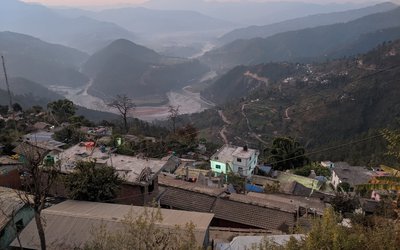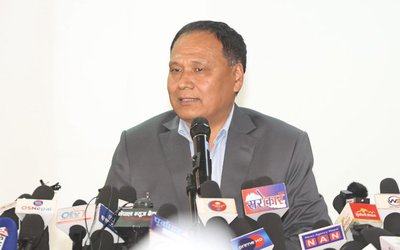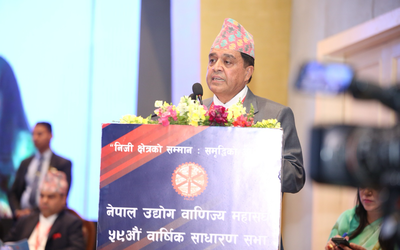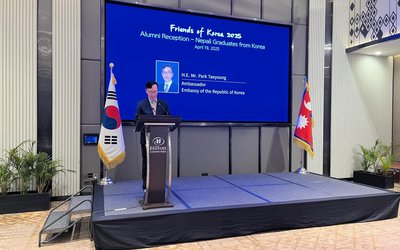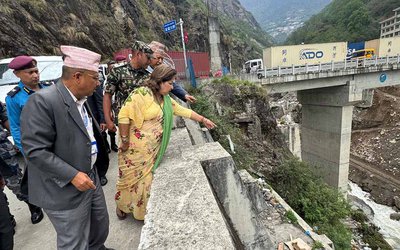
Nepal Electricity Authority has been awarded a 'Double A Plus' rating for the third consecutive time in the latest assessment.
The Nepal Electricity Authority has once again received a 'Double A Plus' rating this year from ICRA Nepal Limited (ICRA Nepal). This marks the third consecutive time the authority has achieved this rating.
The rating is based on an evaluation of the authority's financial health, assets, business and financial risks, management capabilities, and internal and external factors affecting operational efficiency.
Institutions with a double A plus rating are considered to have a strong ability to meet their financial commitments on time, indicating a low risk of default. Credit ratings provide an assessment of an individual's or organization's creditworthiness and offer an opinion on their ability to repay debts. It serves as a clear and easily understandable measure of the risk associated with an organization's debt repayment capacity.
Kulman Ghising, Managing Director of the authority, stated that Redding has been able to achieve a double A plus rating continuously for the past three years, indicating the organization's strong financial health and ability to repay loans. Additionally, Ghising mentioned that the authority can fulfill its financial obligations with confidence.
Ghising explained that the organization's rating, an important criterion for issuing shares to the public, has been completed, and they have evaluated the real assets of the organization.
With government approval, the process of issuing shares can proceed, and they plan to invest the funds raised from the share issuance in the construction of large electricity and hydropower projects.
He further mentioned that there are plans to complete electricity generation projects to enhance the reliability, quality, and safety of electricity supply. This includes necessary system improvements and expansions using profits from the large capital organization and funds obtained from the share issuance.
It has been proposed to issue primary shares to the general public while maintaining the paid-up capital of the authority at around 3 billion rupees and adding a premium of up to 20 percent.
The proposal suggests issuing shares at a price of Rs 300 per share, including the premium. The annual income of the authority is 1 trillion 16 billion, and its assets are valued at over 7 trillion rupees.
The authority was established under full government ownership to enhance the efficiency, reliability, and accessibility of electricity generation, transmission, and distribution. In addition to its domestic operations, the authority engages in both domestic and cross-border electricity trading.
The government invests in the authority through annual budget allocations, share investments (cash or interest/debt capitalization), and other necessary funds and operations to support its electricity development programs.
The authority is a strategic government organization, fully owned by the government, with a monopoly on electricity transmission, distribution, and electricity trading within and outside the country.
The authority has signed a long-term power purchase agreement (PPA) for nearly 11,000 megawatts with hydropower projects developed by both domestic and foreign investors. The rating results indicate that there is minimal investment risk, given the authority's strong financial capacity to fund such projects.
To minimize technical and non-technical power losses, expand access to a larger customer base, lower financial costs, boost revenue, enhance institutional governance, and expand transmission and distribution infrastructure, the authority has made significant strides in generating profits.
NEA achieved a net profit of 1.55 billion rupees in the fiscal year 2073-74, marking a turnaround from the 8.89 billion rupees net loss in the previous fiscal year 2072-73.
In the fiscal year 2080-81, the authority recorded a profit of 14 billion 46 crore rupees. From an accumulated loss of 34 billion 61 million rupees in 2072-73, the authority has now amassed a total profit of 47 billion 41 million rupees.
The authority managed to reduce electricity losses in the system to around 12.73 percent last year, a significant improvement from the 25.78 percent loss recorded in 2072-73.
- Korean Embassy Hosts FRIENDS OF KOREA 2025 Event in Kathmandu
- Apr 19, 2025
- Weather Forecast: Partly To Generally Cloudy With Rain And Thunder Acrosss Nepal
- Apr 19, 2025
- Minister Dahal Directed To Complete The Dannune Portion Of Road Before Monsoon
- Apr 18, 2025
- Kanchenjunga Diamond Festival Being Celebrated From Today To Mark The 70th Anniversary Of The First Successful Ascent
- Apr 18, 2025
- RPP To Hold Protest In Restricted Areas Of Kathmandu On April 20
- Apr 18, 2025
